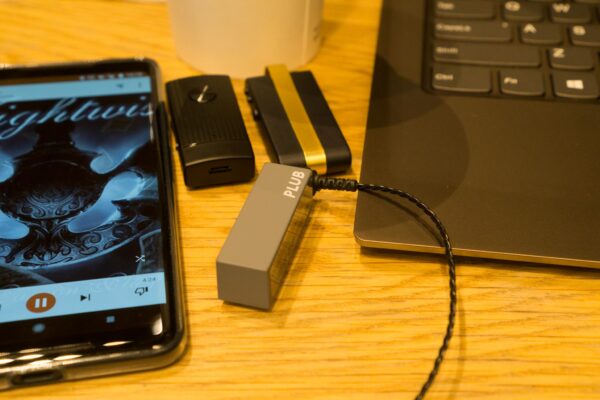
Thanks to one company for removing the 3.5 mm audio jack from their smartphones, and others having since followed suit, we’re left having to deal with Bluetooth audio gadgets. Most people will probably get new Bluetooth headphones, but others like myself who want to use an existing wired device have to grapple with Bluetooth audio receivers.
I’ve nothing against Bluetooth headphones per se. However, some of us may have an existing wired headphones that we’re very happy with, and don’t want to change them. Sometimes, there’s just no easy replacement of those wired headphones. For example, it’s hard to find Bluetooth-enabled custom in-ear monitors.
I assume no one wants to deal with clumsy 3.5 mm audio dongles. It may seem they aren’t much of a hassle if we’re already going to stick with a wired headphones. The dongle is simply an extension of that cable. Unfortunately, that dongle is a very clumsy extension that is a very inconvenient hassle. Worse, if you still want to use that wired headphones with other audio sources blessed with a 3.5 mm audio jack, then there’s a good chance to misplace that dongle, since you won’t have it permanently attached to your headphones cable.
That’s where Bluetooth audio receivers come in. They look like a nice, simple, solution. Unfortunately, they are far from simple, and they are not always very nice.
I wished that Bluetooth audio receivers were just straight-forward adapters. In reality, they are more complicated than may be apparent initially. You’ve got to consider features, capabilities, quality, usability, and numerous other factors.
What is the battery life? Can it be used while charging? What type of audio codecs are supported? How good is the audio quality? How much noise is there? What sort of headphones will work with it? Will it support headphones with inline microphones? Does it have a built-in microphone? Is the gadget convenient to carry around (like clipping it to your pocket)? Are the controls easy to operate?
You’ll be surprised that what sounds like a simple gadget that takes Bluetooth audio streams and outputs analog audio signals to your wired headphones has become such a complicated device.
I had naively hoped that Bluetooth audio receivers would be largely all the same. I’ve since gone through a whole bunch of these gadgets, often finding myself dissatisfied with one or the other, for different reasons.
The Avantree Clipper Pro receiver, for example, has buttons on the outward facing surface that, when you clip to your clothing, is prone to get accidentally activated when you bump into someone or something in a crowded place. Those buttons in question are for volume control, and I’ve found my volume level regularly getting adjusted as I struggle to get around on public transport. It’s very frustrating.
The Jack, a product by Podo Labs which they sought funding for on Kickstarter, didn’t have that problem. However, the Jack is quite noisy. My IEM is somewhat sensitive, and the noise is readily apparently in any quiet moment, which is rather irritating.
The PLUB, another product funded on Kickstarter, was quite promising. It didn’t have any buttons, hence there would be no button problems to deal with. They sold their minimalist design as being simpler to use. I’m not sure about that. Without buttons, “turning off” the device necessitated the physical unplugging of the 3.5 mm audio cable. I didn’t think this was a good idea, but perhaps others may think differently. That’s not the main problem though. The major stumbling block for me was the use of a proprietary charging cable that plugs into the 3.5 mm audio jack. Again, their minimalist design means no separate Micro-USB charging port. I always hate proprietary cables, as losing them becomes a difficult problem. In fact, I’ve lost mine, so the PLUB can’t be used anymore.
FiiO, quite renowned for their audio DAC and amplifiers, also has a Bluetooth audio receiver in their product line-up, the BTR1. It’s a very well-made and well-designed product. Unfortunately, the BTR1 misses out on Qualcomm aptX HD (or LDAC). More significantly, there is a clearly audible high-pitched noise when using aptX with my sensitive IEMs. The noise is avoided by turning off aptX, but hey, I want something better than SBC, even if it may not be easy to tell the difference when travelling on noisy public transport.
Everywhere I turn to, there is going to be some show-stopping compromise. Of course, I’m limiting my scope to reasonably affordable devices. There are very high-end Bluetooth receivers that may be excellent in all respects, but if they are crazily expensive, then that’s not a workable solution either.
I’ve recently finally come across something that looks promising: Radsone’s EarStudio ES100. It has both aptX HD and LDAC, though no aptX Low Latency, no noise with my IEM, sounds good, and overall looks to be a surprisingly capable audio receiver. Look out for my review next month.
If you’re looking for a Bluetooth audio receiver to pair up with your favourite wired headphones, be forewarned that finding something that works for you isn’t going to be easy. In the meanwhile, if you’re looking at the Jack, PLUB, Avantree Clipper Pro or FiiO BTR1, note my comments above.
